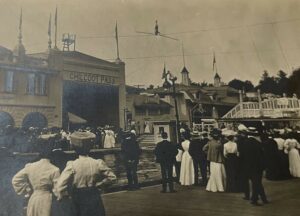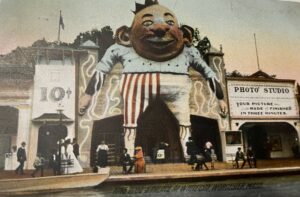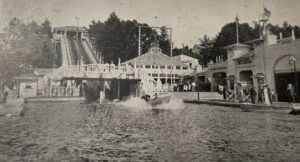By Michael Perna Jr.
Contributing Writer
SHREWSBURY – In 1905, Worcester businessman Horace Holly Bigelow decided to open what would today be called a “cutting edge” amusement park. This was quite a different venture from his previous career—he was a hugely successful industrialist who had made his fortune in the shoe-making industry, inventing machines that were used to make shoes much more quickly than the old method of making them by hand. In 1881, he had opened “Bigelow’s Rink” in Worcester, a roller-skating venue that became very popular—so popular in fact that Bigelow was taken to court by the city because he had the business open on Sundays, which was not allowed at the time. Nothing much ever came of the issue, as times were changing and so did the restrictive guidelines.
On the shores of Lake Quinsigamond
Bigelow actually had built a mansion on the shores of Lake Quinsigamond, on the Shrewsbury shore, just south of what is now Route 9. He decided to build his new amusement park, called “White City,” featuring “Fifty Thousand Electric Lights”—the inspiration for the name coming from an exhibit at the 1893 Chicago World’s Fair—on a large parcel of land adjacent to his mansion.
After several postponements, including a carpenter’s strike, power plant problems, and a near- riot by patrons storming the gates when the park couldn’t be opened on time, the great White City Amusement Park opened on June 18, 1905. Even blazing hot temperatures didn’t dissuade the thousands of excited park visitors.

White City featured many attractions: The “Shoot the Chutes” ride featured boats that would hurtle down a ramp, under a “bridge” packed with park-goers, and plunge into a man-made lake; the “Whirl of Captive Airships” had what today would be known as rocket ships that would spin out over the “Lake.” The “Captive Airships” were pointy on both ends—people in those days didn’t realize that real rockets would have an engine on one end. Another big hit was “King Dodo’s Palace”—which would today be called a “fun house”—which was adjacent to a photo studio that advertised “Your Picture Made and Finished in 3 Minutes.” A miniature railway and restaurant/dance hall which featured the White City Orchestra, and the “Scenic Railway” were other popular features.

Ownership change
Over the years, the park underwent several renovations. The Hamid family bought the park in 1927 and made several changes. One was the “Zip”—a large-scale roller coaster. Another was removing the “Shoot the Chutes” ride; however the man-made lake was still used as a large swimming pool. A roller-skating rink and “Beano” parlor were also added. An elaborate lighted fountain that had been a feature at the 1939 World’s Fair was installed.
White City was hugely popular throughout the region—people would travel by trolley, auto, bus —just about any way they could to visit the park. The late Angeline (LaComfora) Perna, in a 1997 interview, recalled how she and her sister, along with their friends would visit: “We would walk there every Sunday (from their home in West Boylston) to go roller skating. We would only have enough money for the bus ride home, but sometimes ended up getting a ride from one of the boys that had a car.”

There were several games of chance featured in the park, along with a number of food stands selling various treats. The late Joseph “Pony” Lucier, who worked at the park operating the carousel, met his future wife, who worked at one of these stands, there. He recalled: “Popcorn, ice cream, and pop, along with hot dogs and hamburgers, which sold at 5 cents—up to 10 cents, were tasty bargains.” One of the people who got their start working at the park was David “Duddie” Massad, who worked at a stand guessing people’s weights—he went on to become a wealthy businessman who owned several automobile dealerships in addition to other business interests.
The area around the park was full of other businesses that catered to the huge crowds—no less than four diners, a number of nightclubs and bars—“Tilli’s,” “The Happy Hour” and “Palais Royal” were very popular spots. “The Happy Hour” was well known for the many famous Hollywood stars that visited. The late Albert “Lovey” Garganigo recalled spending “one memorable night” (as he called it) at The Happy Hour in the company of the beautiful movie star Jane Russell.
By 1954, a New York businessman, Larry Knohl, with what might be called a “shady past” (he had been associated with Jimmy Hoffa, served time for embezzlement, and was questioned in the slaying of Murder, Inc.’s Albert Anastasia) bought the park. A number of new rides and attractions were installed, including a new “fun house,” a Ferris wheel, a “Roll-A-Plane” ride, miniature golf course and “Kiddie Land” rides. The carousel was moved to the corner of Route 9 and South Quinsigamond Avenue and an old bowling alley was torn down and replaced by a new building housing games and refreshment concessions. A new roller coaster was being built until a severe windstorm on February 25, 1956, destroyed it, leaving nothing but a heap of rubble. Fortunately, the storm occurred at night, so no one was injured.
Decline and closure
Despite hosting several famous acts to a packed house, such as Frankie Avalon, Paul Anka, Jerry Vale, Edie Gorme, Dagmar, and Bobby Darrin, White City fell on hard times. Rumor had it that Knohl had not been paying taxes on the park. Labor Day 1960 was the park’s last day of operation, after a 55-year history of thrilling thousands upon thousands of patrons.
The park was bought by Albert Shore, a Rhode Island businessman from Providence. After a series of fires destroyed many of the park’s buildings, an auction was held, selling off the park’s rides. The carousel was purchased and later operated at several amusement parks around the country until ending up at a park in Florida. The carousel’s horses were then sold off to collectors.
White City’s land was turned into one of the area’s first shopping centers, which featured a Bradlee’s department store, a supermarket and several other stores. The “White City” name was retained, and the shopping plaza was later expanded to “White City East.” A movie theater was later added, which is now closed and replaced by a restaurant.
The famed White City amusement park is still fondly remembered by many local residents, even after having been closed for sixty-four years.
RELATED CONTENT:
Whalom Park in Lunenburg promised “a whale of a time”
Take a spin back in time at these memorable roller-skating rinks












